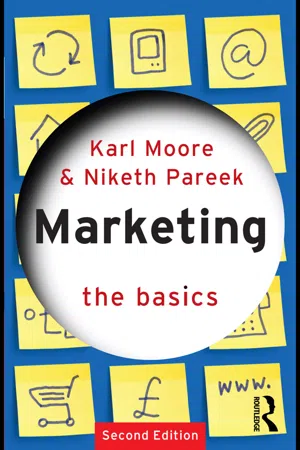Marketing
Sales Force
A sales force refers to the team of individuals within an organization who are responsible for selling its products or services. This team typically includes sales representatives, account managers, and sales managers who work together to generate revenue and build relationships with customers. The sales force plays a crucial role in driving the company's sales and achieving its revenue targets.
Written by Perlego with AI-assistance
8 Key excerpts on "Sales Force"
Learn about this page
Index pages curate the most relevant extracts from our library of academic textbooks. They’ve been created using an in-house natural language model (NLM), each adding context and meaning to key research topics.
- eBook - ePub
- Marcos Fava Neves(Author)
- 2012(Publication Date)
- Routledge(Publisher)
In this chapter, first the relationship between sales, marketing strategy and business strategy will be discussed. Once this role is understood, the rest of the chapter is organized according to decisions necessary for sales planning and sales organization. These decisions are: establishing criteria for operation of the Sales Force in the market, implementation of the Sales Force, which will be referenced as “human resources in sales” topics, how to acquire and maintain a well-prepared and motivated sales team and, finally, the ways of controlling sales. In summary, the following analyses should be undertaken when making a company sales plan:- analyze the current Sales Force situation and define the objectives for the next period, both based on performance indicators;
- define the way in which salespeople will approach customers (strategy);
- outline the limits of the Sales Forces’ actions, directing their efforts, and whether to establish a support team for the company;
- define the ideal number of salespeople for the company (size), and establish how they should be compensated (wages);
- recruiting, selecting, supervising, motivating, and training the sales team are necessary to guarantee work continuity;
- undertake evaluation and monitoring in order to reach objectives, which includes following up issues identified in earlier steps;
- network actions, in cooperation with competitors and other companies that operate in the same target market, can also be undertaken;
- a Sales Force budget should be developed.
A Sales Force needs to be totally integrated with other marketing elements to produce the greatest impact possible, because a coordinated marketing mix has a greater power over consumers (Rogers, 1993; Churchill et al., 2000).The Sales Force has an immense potential for increasing company sales, but on the other hand, it can ruin the whole marketing strategy (Zoltners et al., 2001).Business Strategy, Marketing Strategy and Sales Force Management
This section presents two major considerations. The first is related to the importance the Sales Force has within the company. The second, since it is an important function, is which considerations are in the literature regarding integration of company and marketing strategy and sales management. - eBook - ePub
- William Winston, Tony Carter(Authors)
- 2013(Publication Date)
- Routledge(Publisher)
Section I: Introduction to Contemporary Sales Force ManagementPassage contains an image
Chapter 1 The Role of the Sales Force Manager in Organizations
Contemporary Sales Force Management
Sales performance levels are interesting concepts for the purposes of managing the Sales Force. Sales is the lynchpin of capitalism; sales drives activity in today's business world. As such, sales is not just a profession, but also a process that has relevance to anyone in business. It is the essence of business itself.Sales managers today must develop an integrative management style using adaptive, problem-solving, extensive information, in many cases in an ever-changing marketplace. The overwhelming majority of business environment workers are service providers such as investment bankers, consultants, and information technology specialists. Sales managers in the current business environment must have the ability to add value, which certainly means functional expertise in sales and marketing along with knowledge of the industry. However, managers must also have the skills to lead, communicate, use changing technologies, build teams, motivate salespeople, form strategic alliances with customers, and build teams within the Sales Force. Sales managers need access to a flow of reliable information to initiate sound decision making that turns on a dime. As a necessary precondition to high levels of Sales Force performance, empowerment, and control of their own work process, sales managers should also have a system of sharing information with the Sales Force.1These are times of drastic corporate downsizing in which sales organizations are expected to do more with less. Sales managers must also be more knowledgeable and possess a myriad of demanding new business skills. Many internal and external changes among organizations have dictated the need to conduct business differently. The external business environment has experienced changing technology, globalization, catastrophic business crisis, a more frantic competitive climate, and more demanding, sophisticated customers. Internal changes have included reengineering, accompanied by structural realignments and downsizing, greater emphasis on quality levels in product and service output, faster communication channels, and a more educated, skilled employee base with higher expectations from management.2 - eBook - ePub
Marketing Methods to Improve Company Strategy
Applied Tools and Frameworks to Improve a Company's Competitiveness Using a Network Approach
- Marcos Fava Neves, Luciano Thome e Castro, Matheus Alberto Consoli(Authors)
- 2010(Publication Date)
- Routledge(Publisher)
The favorable aspects of the proposed sequence, compared to the other frameworks, could be that it stresses, at the beginning of the sequence, the governance mode to regulate the relationship between the firm and its salespeople, and tries to anticipate the side effects of this choice. Firms should think of all these steps before making decisions. Also, it offers potential interfaces among marketing variables; trying to integrate the marketing efforts in a coordinated way, when thinking of needed marketing activities for satisfying consumers. It inserts a topic of information and communication design within the sales organizational structure and inserts a topic for conflict management, dealing with channel conflict, and territorial conflicts, among others.Summary
Sales Force is a broad and well-explored field of research. However, most conceptual frameworks for sales planning and management emphasize just one aspect or another and lack managerial orientation towards an organized group of actions for sales managers. Besides, actual environmental changes ask for new considerations and a deep exploration on aspects, which are briefly discussed in general frameworks. After a short introduction on sales literature, this chapter highlights marketing changes that motivate important reflections on sales planning and management, and proposes a new framework. The proposed framework aims to organize the main tasks of the sales manager in a logical sequence of steps and consider the complexity of this particular marketing variable and its potential for creating strong relationships with most valued clients and thus gaining competitive advantage. Ten steps are presented with tables and charts to be filled in by readers.Questions
1 Think of a salesperson of industrial products such as packaging materials and systems. How can we think of his or her strategic roles and how can we formulate an incentive system for this role? Use the proposed charts in the chapter (sections 6.2 and 6.4 ).2 Give an example of marketing integration to each of the marketing variables. Use and fill in Table 6.3 .3 How does the Internet facilitate the communication and information flows needed to manage the sales team? - eBook - ePub
Managing the Sales Organization
For the Digitial Age
- Anders Sahlgren, Erik Skog(Authors)
- 2019(Publication Date)
- Sahlgren & Skog KB(Publisher)
The drawback is that it’s an expensive way to reach the market. Salaries and expenses for a sales organization are usually high, and management and support functions need to be in place in order to take advantage of its strengths.How you structure and manage the sales organization, i.e. how you utilize this valuable resource, is the topic of this book. To put it differently: How do you maximise the return on the investment you put in a sales organization?The company’s channel strategyThe Sales Force is one of many channel options in establishing contact with the customers and generating sales. It’s an important part of the company strategy to evaluate and select the right channels suitable for their specific situation. Another part of this process is deciding and allocating the necessary resources in operating these channels. This is what frequently is called the company’s channel strategy.The different channel options are illustrated in figure 1.2 , below.Figure 1.2 The company could choose one or several channels when approaching the customers. (Adapted from Zoltners & Sinha, 20012 )As the figure shows you can have a personal or non-personal approach to the customers. The personal approach could be done through a Sales Force or through telesales, and both these channels come in two versions: Direct sales , when you approach and sell to the end customer with your own sales people, and indirect sales , where your sales people sell through a third party, who in their turn sell to the end customer. Examples of these third parties are resellers, such as agents (independent representatives for the company in a certain market), distributors (keeping inventory and supplying the company’s products to their customers) and value-added partners (adding value to the company’s products before selling it to their customers).The personal approach could be substituted or complemented by a non-personal approach. Here, channel examples are advertising (creates an interest for the company’s products), direct marketing (sending material directly to the customers to encourage them to contact the company and order the products, e.g. catalogue sales) and e-commerce. These channels are sometimes under the management and control of the sales organization, sometimes they are separate and report to other functions in the company. - eBook - ePub
- Karl Moore, Niketh Pareek(Authors)
- 2009(Publication Date)
- Routledge(Publisher)
Sales is a profession where individuals face high rejection rates, where they work in isolation and where they too often find themselves constantly travelling. As we stated in the first chapter, avoiding isolation and enhancing self-esteem are important determinants of human behaviour. Because the work conditions are antithetical to those activities there is an impression that successful salespeople must have an innate ability to sell. In other words, some are born to sell, others not. Selling is not genetic. Studies show that to succeed in sales, one must be a risk-taker, be resourceful, be able to empathize and be filled with a nearly unbounded reservoir of self-confidence. Every human possesses these qualities and traits, however, the degree to which they are developed varies from person to person. Managers must therefore develop strategies that enhance a person’s selling skills and reinforce a person’s sense of purpose. One of the most famous and well-read sales motivation writers is Zig Ziglar. One of his key points is that a salesperson must learnFigure 8.1 The Sales Force management modelto like hearing no. When you have heard seven nos, you know the next person will say yes. Statistically this is true. The first person has a 50 per cent chance of saying no, the second has a 25 per cent chance, the third, 12.5 per cent. Halving the probability of rejection four more times will equal zero. This sounds particularly silly to most people but for many salespeople this actually makes sense.We define Sales Force management as the analysis, planning, implementation and control of all activities related to the Sales Force. These activities include crafting the structure of the sales department, delegating the tasks conducted by the salesperson, designing the selling strategies employed by the Sales Force and all actions related to recruiting, training, compensation and evaluation of the Sales Force. Figure 8.1 illustrates the Sales Force management model.Sales Force STRUCTURE
A study published by Benson Shapiro and Stephen Doyle reported that salespeople whose tasks that were clearly articulated performed better than those whose weren’t. More surprisingly, the two concluded that sales-task clarity, as they called it, had a greater impact on employee motivation than the salary or the seller’s personality. What managers can learn from Shapiro and Doyle’s study is that salespeople are more responsive to clarity than monetary incentives. Clearly defining the roles of Sales Force – or structure, in management speak – increases the likelihood the salesperson acts in a manner congruent to the goals of the corporation, which is to build long-term relationships with customers through satisfying current, and anticipating future, needs. - eBook - ePub
- Nikala Lane(Author)
- 2013(Publication Date)
- Routledge(Publisher)
When marketing and sales functions work well together, they can create and deliver superior customer value. Hence, it is crucial for seamless value creation and delivery that the sales–marketing interface remains frictionless (Dewsnap & Jobber, 2000, 2002; Guenzi & Troilo, 2007). Extant research suggests that in many business organizations, marketing is typically in charge of strategy creation activity, while sales is entrusted with the task of strategy implementation (Kotler, Rackham, & Krishnaswamy, 2006; Rouziès et al., 2005). Recent advances in our understanding of this phenomenon however, suggest that the changing business landscape and newly emerging competitive threats are requiring firms to rethink the role sales organizations may play in the strategy creation and implementation processes (Ingram, 2004; Leigh & Marshall, 2001; Piercy & Lane, 2003).Specifically, scholars have argued that in future, firms must not look at their sales organizations as pure ‘executors’ of marketing strategy, but they must embrace sales organizations that will shoulder important strategic decision-making responsibilities with marketing; that is, the strategic sales organizations. Relatedly, Piercy (2006) and Piercy and Lane (2003) suggest that as business firms prepare for the emergence of the strategic sales organizations, they must consider five important imperatives of this transformation: the need for integration across sales and marketing, involving Sales Force in strategic process, capturing and using the intelligence generated by salespeople, effectively marketing the customer internally within the organization, and aligning sales structures and processes with the broader business strategy.While this transformation presents exciting opportunities, firms must keep in mind that certain intra-organizational factors may facilitate or challenge the emergence of a strategic sales organization and its resultant imperatives. Given that sales and marketing functions are ideally jointly involved in the strategy making and execution process, and that the sales–marketing interface has been known to be acrimonious (Dewsnap & Jobber, 2000; Homburg, Ove, & Krohmer, 2008; Lorge, 1999), studying the likely facilitating factors and challenges to this transformation through the sales–marketing interface perspective can offer a greater insight into this emerging phenomenon. - eBook - ePub
Sales Management
Analysis and Decision Making
- Thomas N. Ingram, Raymond W. LaForge, Ramon A. Avila, Charles H. Schwepker Jr, Michael R. Williams(Authors)
- 2019(Publication Date)
- Routledge(Publisher)
To succeed in such a complex setting, sales organizations must focus on the customer and strive for more trust-based, long-term relationships. Sales must become a “smarter” business function, meaning that sales strategy becomes more important. As will be discussed in Chapter 3, this often means developing new sales channels, or ways of reaching customers. To keep abreast of an ever-changing environment, sales organizations must become continual learning organizations and recruit salespeople who can adapt to diverse cultures, languages, and business practices. Collaboration The sales function is finding it increasingly important to collaborate with other functional areas within their companies and with customers. Within their own companies, the need for sales to integrate and cooperate more with production, finance, and marketing is getting a lot of attention in the business world. In particular, the importance of better alignment between sales and marketing is widely acknowledged as indicated by the American Marketing Association’s training seminars on the topic. To improve collaboration between sales and marketing, the two parties should agree on critical customer issues such as identification of customer segments and the related needs, buying motives, purchasing processes, and relevant value dimensions within those segments. 16 Clearly, this need for more collaboration should be addressed by cross-functional training and communications programs. Greater collaboration is also needed between sales managers and salespeople, and sales managers should strive to earn the trust of their salespeople rather than over-relying on the authority provided by their supervisory position. With customers, collaboration should extend the concept of customer-oriented selling to include problem solving and involving the salesforce in recovering from service problems that may arise - eBook - ePub
Creating a Thriving Business
How to Build an Immensely Profitable Business in 7 Easy Steps
- George Horrigan(Author)
- 2012(Publication Date)
- Morgan James Publishing(Publisher)
Keep in mind that everyone in your business is in Marketing and Sales in some way. Even if they are not directly employed in your Marketing and Sales areas, during the year they will talk to various people who are theoretically potential customers. You want them to tout the attributes of your products and business. This fact is another reason why, as we discussed earlier, you need to have your employees on board with your Vision for your business.Back in Chapter 4 , you identified your Critical Success Factors and you separated them into the four areas of your business. Please take a minute and review your Critical Success Factors for the Marketing and Sales area. As we work through this chapter, you will have the opportunity to update and add to the Critical Success Factors you have already identified.While the Marketing and Sales function of a business is generally considered one area, it is in reality two separate areas that are very closely related to each other. The objective of your Marketing area’s function is to bring prospective customers to you and the function of your Sales area is to actually close the sale. This chapter starts with an overview of both areas and focuses on the Marketing area for the rest of the chapter. Sales and related areas are covered in Chapter 6 .OVERVIEW OF YOUR MARKETING AND SALES AREA
When you think of your Marketing and Sales area, you should think of the word “opportunity.” Opportunity is the key to your Marketing and Sales area.The size of your opportunity refers to how large your potential market is. Determining this involves analysis of the market that presents itself to you and the solution you can provide this market. The result of this analysis determines the potential size of the opportunity that is available to your business.Therefore, you must first determine who your Customer is and how large the market is for your product. Once you have done this, you can determine how you can take advantage of the opportunity that presents itself to you. The development of the Strategy for taking advantage of the potential market for your product and then reaching out to that market is what takes place in your Marketing and Sales area.







